Why Read This Article?
Finish Nailer Repair - Replacing the Driver Guide (Ridgid Part # 79004001022)
Article Breakdown
Finish Nailer Repair - Replacing the Driver Guide (Ridgid Part # 79004001022)
Tools & Materials
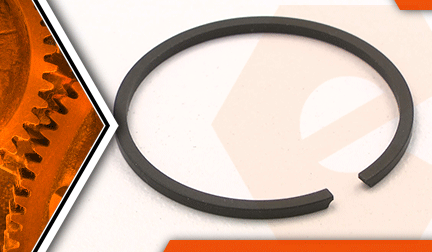

String trimmer out of whack? It's time to face the fix. Whether you are a legendary landscaper or a weekend weed whacker, eReplacementParts.com provides the parts, procedures and facts you need to fearlessly fix what fails you.
The piston ring forms the seal between the piston and the cylinder. This seal separates the combustion chamber and the cylinder from the crankcase. During normal operation, the piston ring does not actually touch the cylinder wall (a thin film of oil separates the two components).
A worn or broken piston ring will allow combustion gases to escape the seal and enter the crankcase, causing low compression and a loss of power. If compression is reduced significantly, the engine will not run at all.
Damage to the piston ring can occur several ways: Lack of oil will allow the ring to contact the cylinder, causing scoring and (eventually) seizure of the engine. Dirt in the cylinder will act like sandpaper, quickly wearing away the piston ring. Using old or stale fuel will cause varnish build-up, which will eventually "glue" the ring to the piston.
Because the piston ring seals against the cylinder, any of these conditions will often cause similar damage the cylinder. Therefore, whenever you are investigating a piston ring problem, you should also carefully inspect the cylinder for damage.
This article provides step-by-step instructions for removing and installing the piston ring on an Echo SRM-225 trimmer.
Let's get started.
 REMOVING THE PISTON RING [top]
1. Remove the air cleaner assembly.
REMOVING THE PISTON RING [top]
1. Remove the air cleaner assembly.
Loosen the thumb screw.
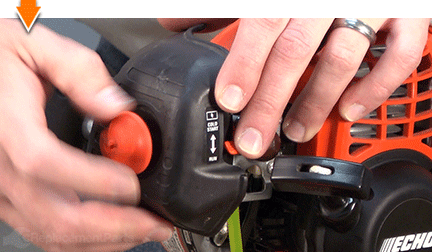
Remove the air cleaner lid.
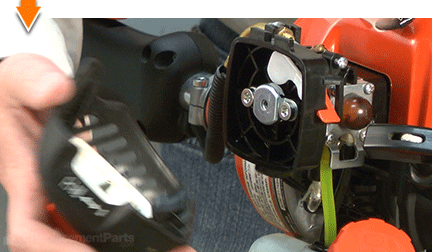
Remove the air filter.
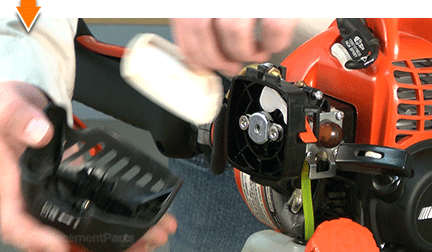
2. Drain the fuel.
Drain the fuel before servicing the unit.
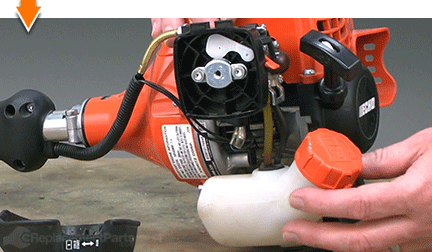
3. Remove the air cleaner case.
Loosen the (2) bracket retaining screws.
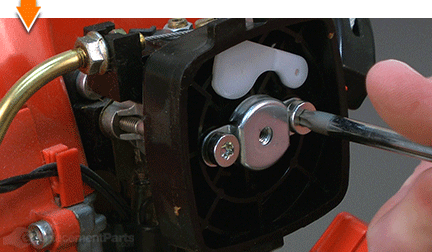
Remove the air cleaner case (along with the bracket and the screws) from the engine.
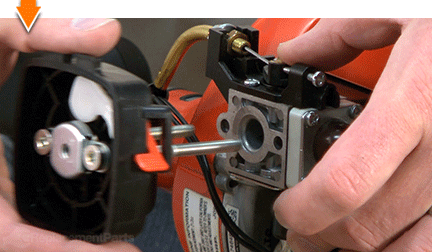
4. Remove the carburetor.
Use a wrench to loosen the throttle cable adjusting nut.
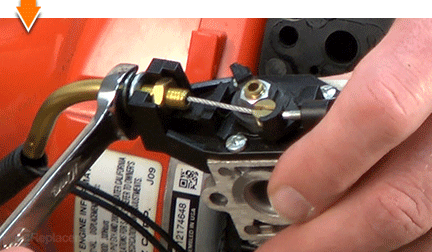
Disconnect the throttle cable from the throttle body.
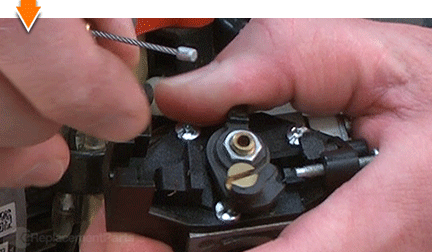
Disconnect the (2) fuel lines from the carburetor.
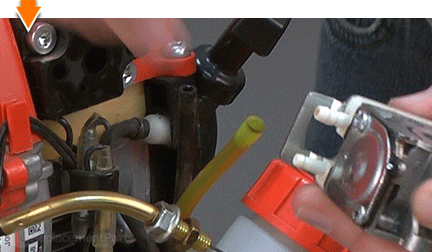
Remove the carburetor from the engine.
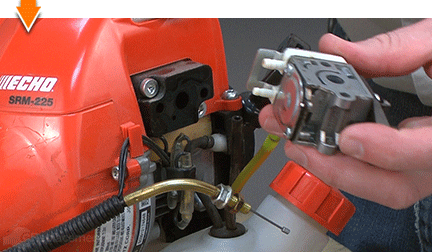
Locate and remove the intake insulator gasket. (This gasket is situated between the carburetor and the intake insulator block. Typically, the gasket will fall away from the two components as they are separated. Sometimes, the gasket will remain affixed to either the carburetor or the intake insulator block.)
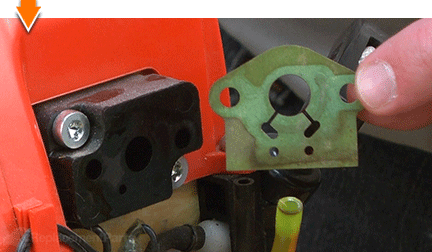
5. Remove the intake insulator block.
Remove the (2) retaining screws.
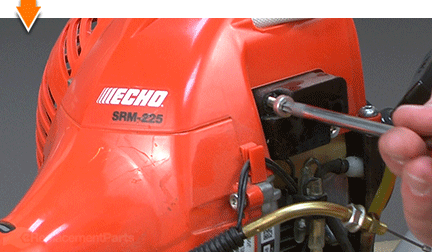
Remove the intake insulator block from the engine.
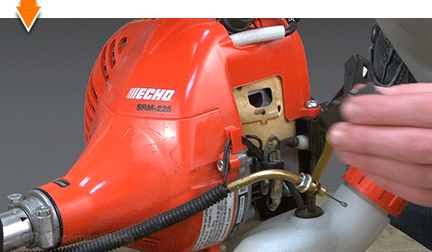
6. Remove the spark plug from the engine.
Disconnect the spark plug boot from the spark plug.
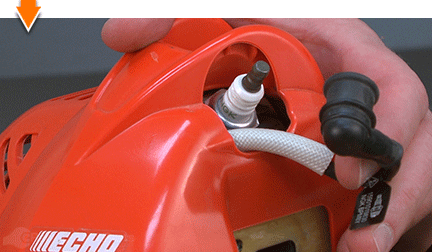
Use a spark plug wrench (or socket) to loosen the spark plug.
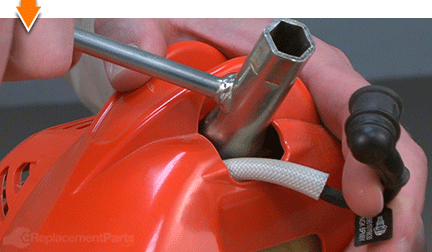
Remove the spark plug from the engine.
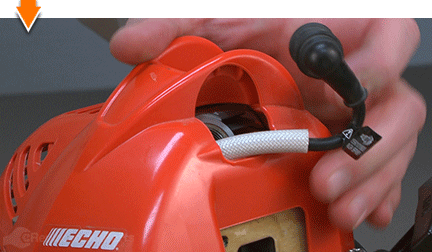
7. Remove the engine cover.
Remove the (2) retaining screws from the engine cover.
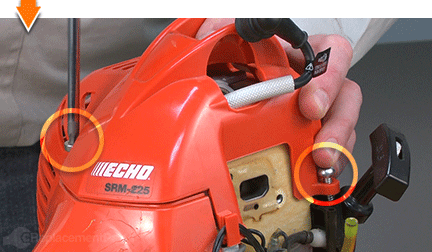
Lift and remove the engine cover from the engine.
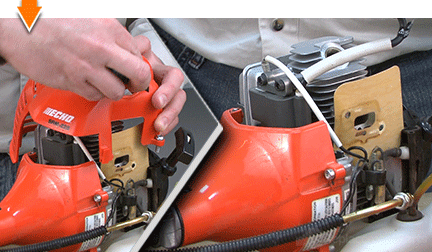
8. Remove the intake insulator gasket.
Remove the intake insulator gasket from the engine.
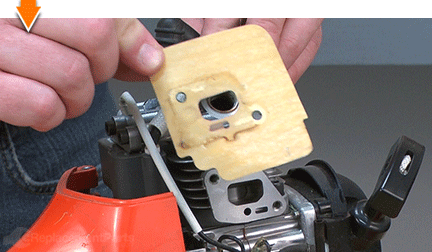
9. Remove the starter assembly from the engine.
Remove the (4) screws from the FACE of the starter assembly.
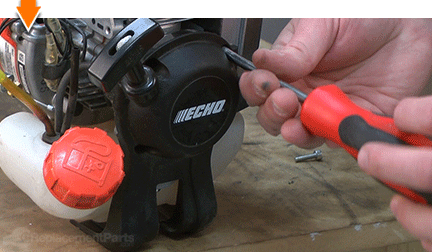
Remove the (1) screw from the SIDE of the starter assembly.
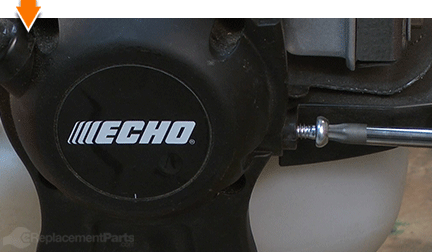
Remove the (1) screw from the BOTTOM of the starter assembly (this screw passes through the fuel tank).
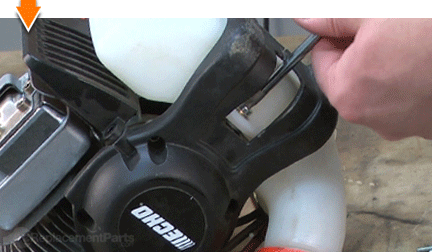
Pull the starter assembly away from the engine.
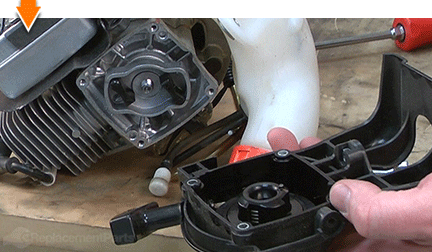
10. Remove the fuel tank from the unit.
Remove the (2) remaining screws from the fuel tank.
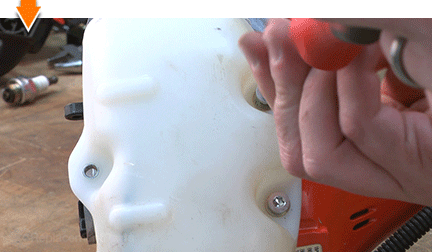
Remove the fuel tank from the unit.
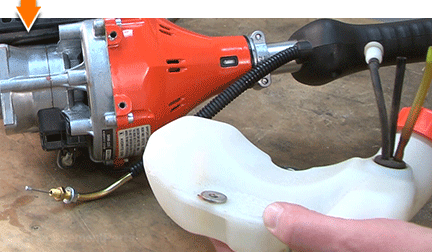
11. Remove the air duct from the engine.
Remove the (1) screw from the air duct.
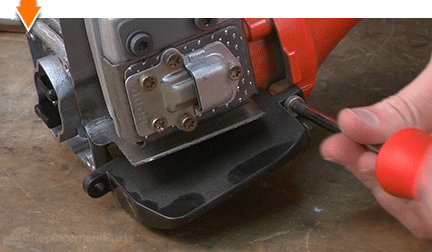
Remove the air duct from the engine.
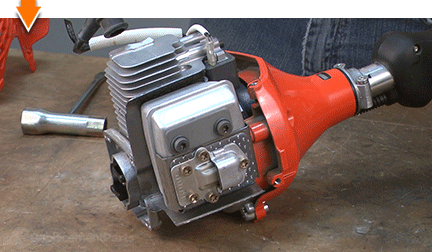
12. Separate the engine from the clutch/shaft assembly.
Disconnect the ignition wires (at the connectors).
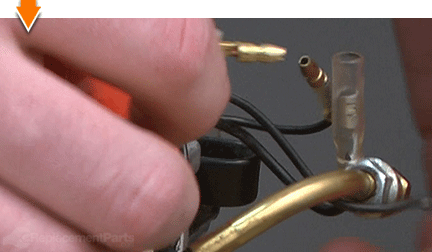
Remove the (4) screws from the clutch/shaft assembly (two from the top half; two from the bottom half).
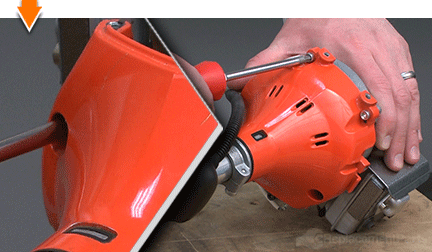
Use a rubber mallet to tap the engine away from the clutch/shaft assembly.
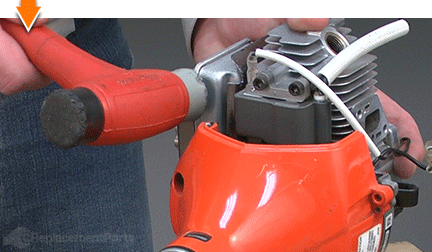
Separate the engine from the clutch/shaft assembly.
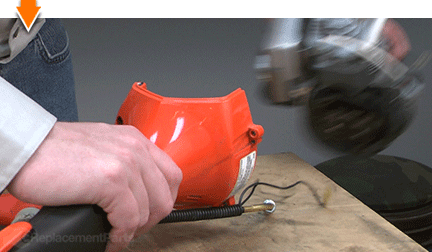
13. Bind the engine.
This step effectively binds the engine, which facilitates the removal of key components (described in subsequent steps). Begin by inserting either end of an old starter rope (or similar rope) into the engine cylinder (through the spark plug hole). Continue feeding the rope into the cylinder until the piston is unable to move.
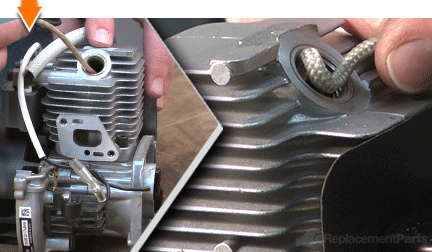
14. Remove the clutch from the engine.
With the engine bound; use adjustable pliers to rotate (loosen) the clutch.
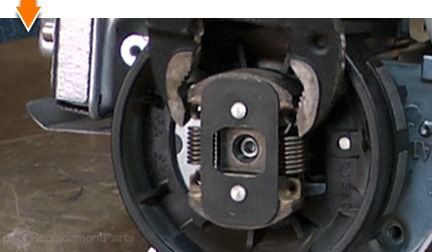
Unthread and remove the clutch from the spindle.
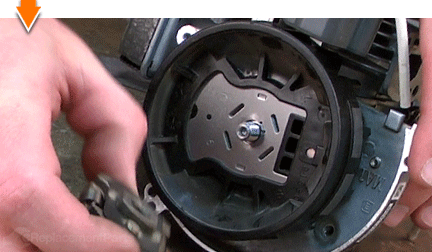
15. Remove the flywheel from the engine.
Securely grasp the flywheel in one hand.
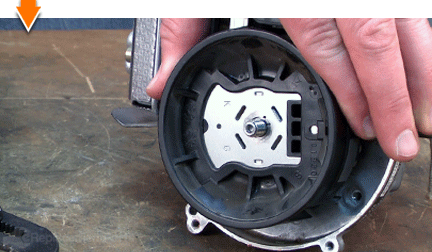
Use a RUBBER mallet to tap on the center of the spindle while pulling the flywheel in the opposite direction (away from the engine). Do not use a metal hammer; doing so will damage the spindle.
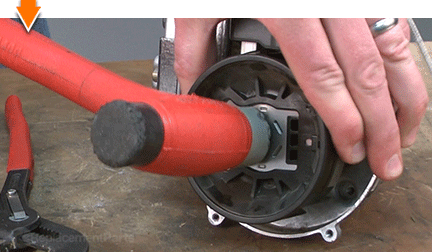
Remove the flywheel from the engine.
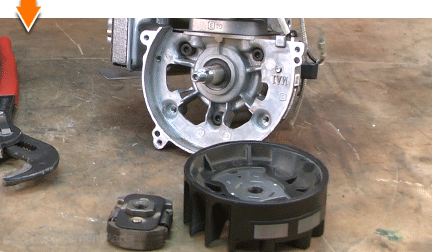
16. Remove the starter pulley from the engine.
With the engine bound; use adjustable pliers to rotate (loosen) the starter pulley.
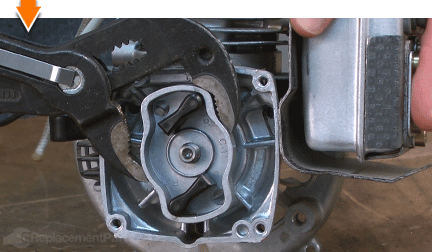
Unthread and remove the starter pulley from the spindle.
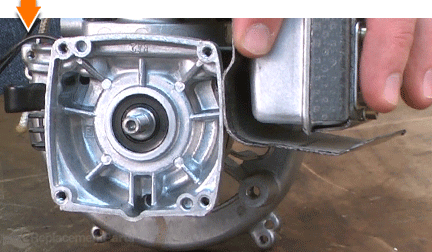
17. Unbind the engine.
Remove the starter rope from the engine cylinder.
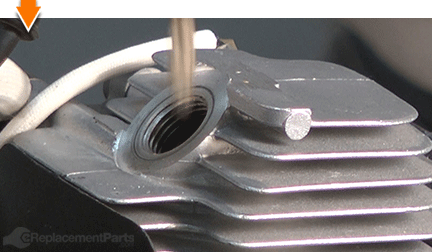
18. Remove the muffler from the engine.
Remove the (2) retaining screws from the muffler assembly.
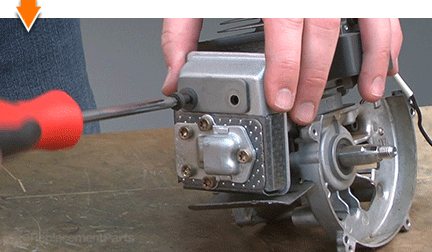
Remove the muffler assembly from the engine.
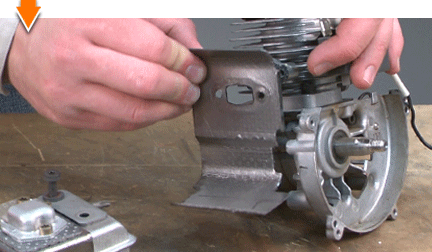
19. Separate the cylinder from the crankcase.
Remove the (2) retaining screws from the cylinder. The first screw can be accessed from the side of the cylinder.
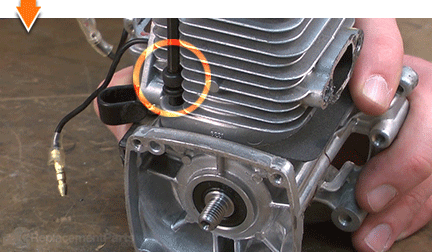
The second screw must be accessed through the hole in top of the cylinder head.
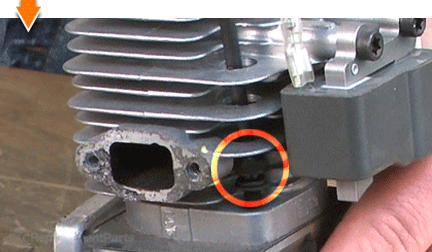
Separate the cylinder from the crankcase.
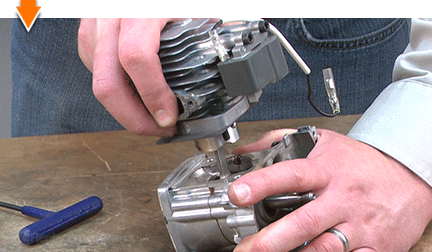
20. Remove the piston ring.
Gently pry the piston ring out of the groove in the piston (use your fingers to avoid damaging the piston).
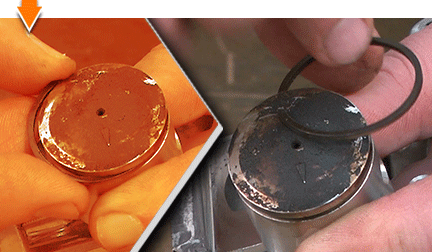
Remove the piston ring from the piston.
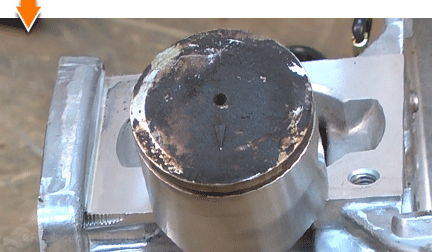
INSTALLING THE NEW PISTON RING [top] 21. Install the piston ring.
Note that the ends of the piston ring (on each side of the gap) are milled to form a quarter-circle. The ring needs to be installed with the circular sections facing the top of the piston.
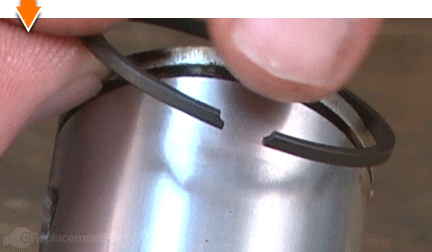
The gap in the piston ring needs to align with the pin in the piston.
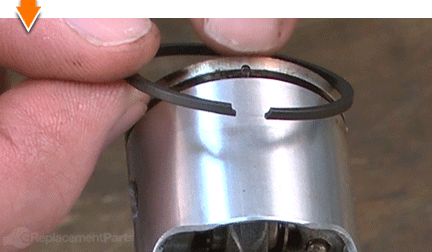
Install the new piston ring onto the piston. The gap will allow just enough flexibility to work the ring into position. Be careful; the ring will break if bent or stretched too far.
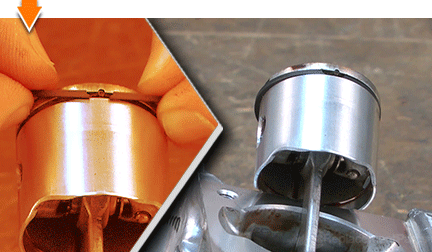
REASSEMBLING THE UNIT [top] 22. Reinstall the cylinder.
Use a razor blade to scrape/remove any gasket fragments or debris from the surfaces of the cylinder and the crankcase.
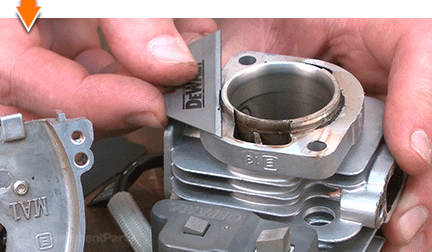
Lubricate the inside of the cylinder and the outside of the piston assembly with 2-cycle engine oil.
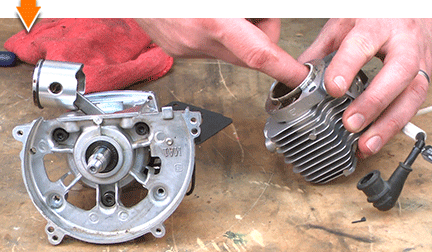
Reinstall the gasket onto the cylinder. (A new gasket is recommended).
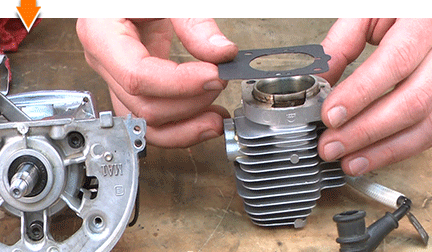
Align the two components: The cylinder assembly contains the ignition coil; this coil needs to face the same direction as the LONGER portion of the crankshaft (in order to engage the flywheel).
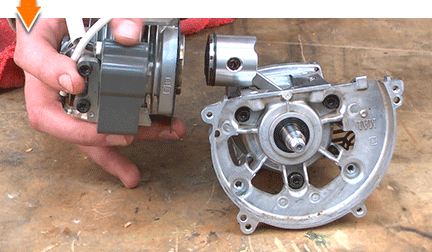
Carefully slide the cylinder over the piston assembly; ensure that the piston ring slides smoothly into the cylinder. (Do not force the piston into the cylinder.)
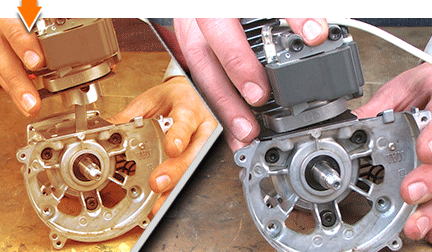
Secure the cylinder to the crankcase with the (2) screws.
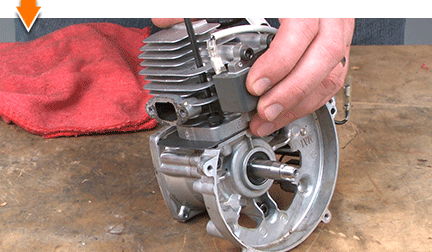
23. Bind the engine. (Again.)
Insert either end of an old starter rope (or similar rope) into the engine cylinder (through the spark plug hole). Continue feeding the rope into the cylinder until the piston is unable to move.
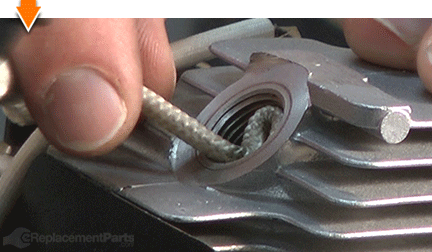
24. Reinstall the starter pulley.
Thread the pulley onto the crankshaft spindle.
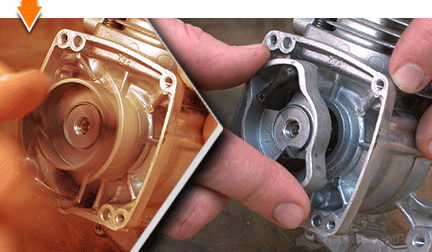
Use adjustable pliers to secure the starter pulley.
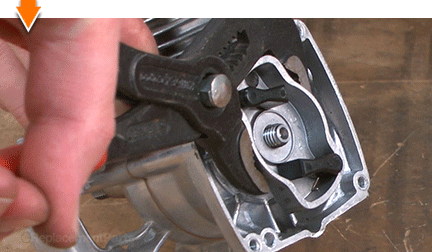
25. Reinstall the flywheel.
Note that the flywheel contains a pre-molded key which is designed to align seamlessly with the keyway on the crankshaft.
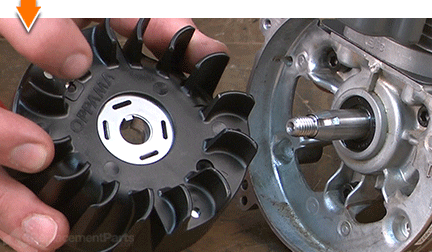
Install the flywheel onto the crankshaft spindle, ensuring alignment of the keyway. The cooling fins should be facing the engine.
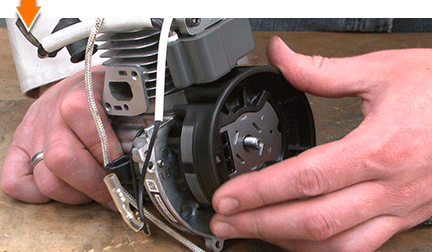
Using a rubber mallet, tap around the inside surface of the flywheel (not the spindle). It is not necessary to completely secure the flywheel with the mallet; just tap it enough to ensure that the internal components engage and seat properly. Installation of the clutch (next) will secure the flywheel to the crankshaft.
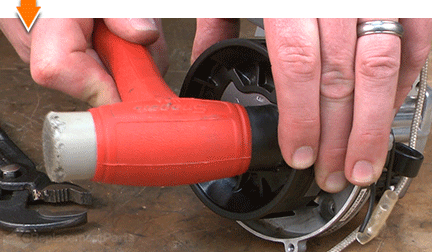
26. Reinstall the clutch.
Thread the clutch onto the crankshaft spindle.
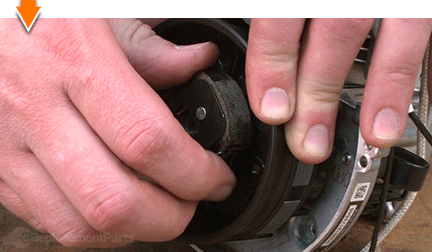
Use adjustable pliers to secure the clutch.
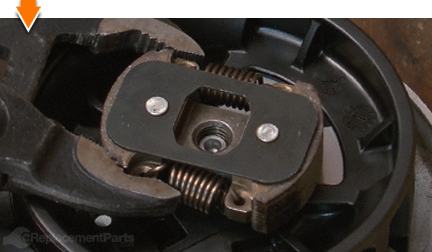
27. Unbind the engine. (Again.)
Remove the starter rope from the engine cylinder.
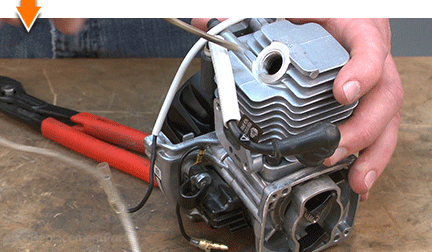
28. Set the ignition air gap.
An ignition gapping gauge is recommended to accurately complete this step. However, if you do not have an ignition gapping gauge (measuring #.014 or .35mm) it is usually acceptable to use one thick business card or two thin business cards as substitutes.
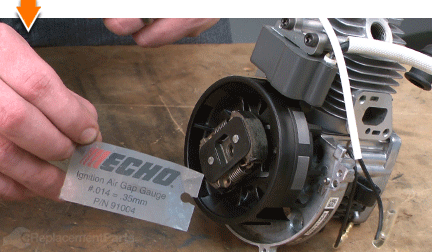
Loosen the two screws on the ignition coil (enough to allow the coil to move freely).
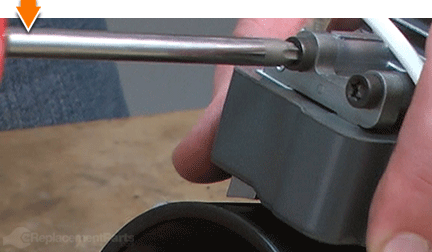
There are two magnets on the outside of the flywheel. Rotate the flywheel until these magnets align with the contacts on the ignition coil.
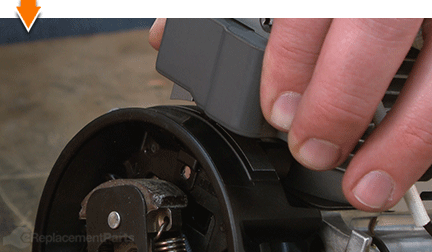
Insert the ignition gapping gauge between the ignition coil and the flywheel.
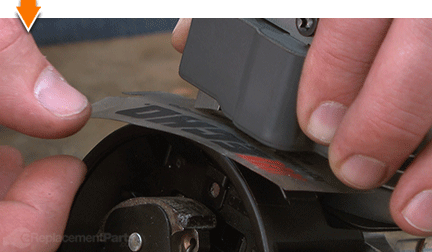
Adjust the position of the ignition coil until the contacts engage the magnets of the flywheel.
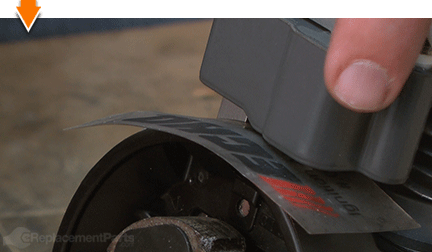
Re-secure the ignition coil with the (2) screws.
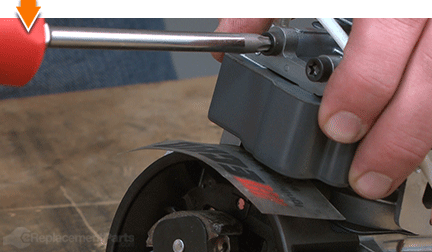
Remove the gapping gauge.
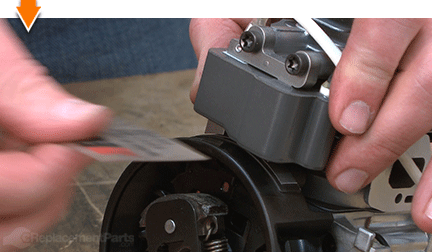
29. Reinstall the muffler and gasket assembly.
Inspect the muffler gasket for damage; replace it as necessary.
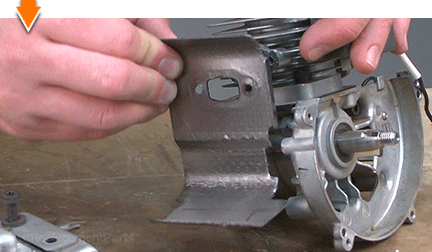
Install the muffler and gasket assembly onto the engine.
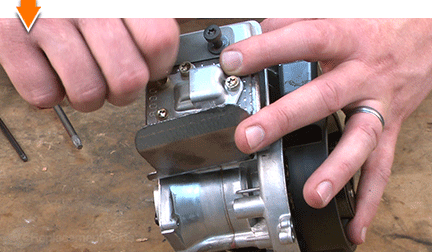
Secure the muffler and gasket with the (2) screws.
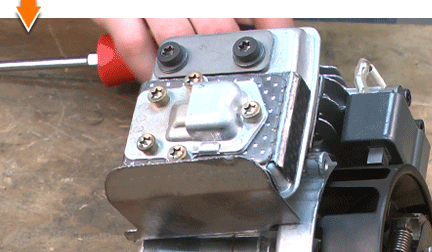
30. Reconnect the engine to the clutch and shaft assembly.
Reconnect the engine assembly to the clutch and shaft assembly.
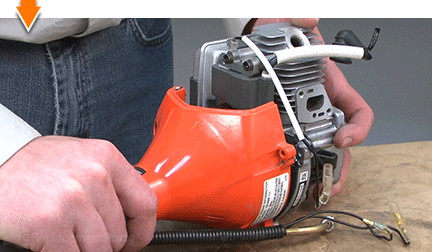
Verify that the alignment pins are properly engaged.
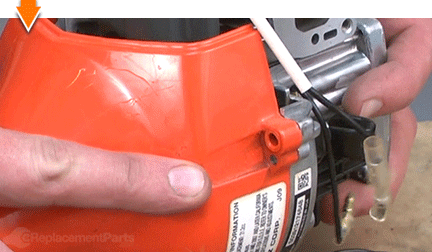
Secure the clutch and shaft assembly to the engine with the (4) screws.
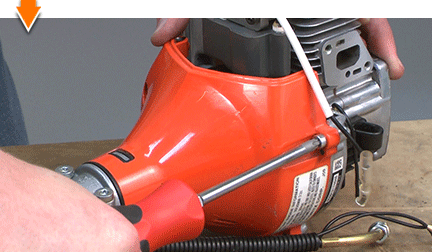
31. Reconnect the ignition wires.
Reconnect the ignition wires.
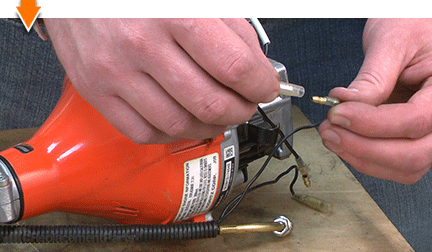
Tuck the wire connections into the holder on the side of the ignition.
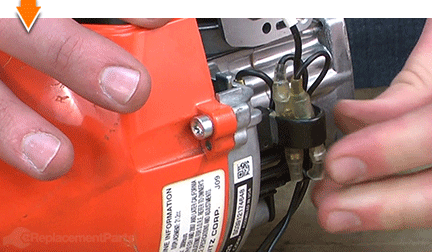
32. Reinstall the fuel tank.
Align the fuel tank with the mounting holes on the bottom of the engine.
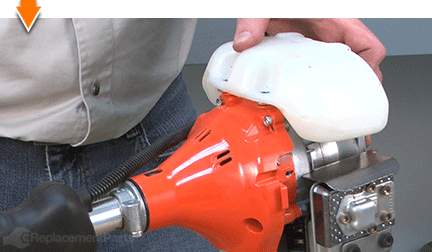
Secure the fuel tank with the (2) screws. Both of the screws should be on the same side of the fuel tank at this point. The remaining hole on the opposite side of the fuel tank will be used to attach additional components in later steps.
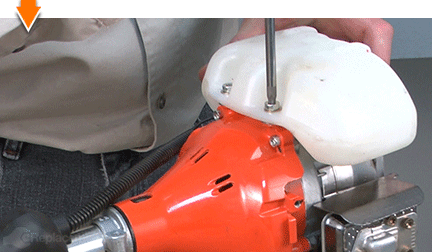
33. Reinstall the air duct.
Install the air duct between the muffler and the fuel tank.
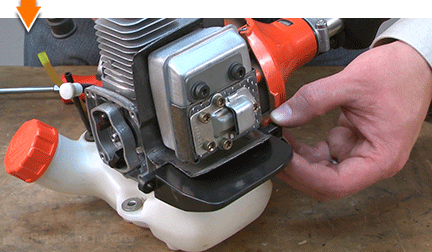
Secure the air duct with a single screw (the outermost hole should remain open at this point).
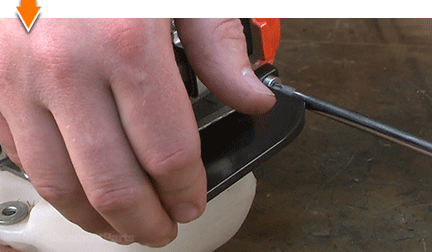
34. Reinstall the starter assembly.
Align the starter assembly with the mounting holes at the rear of the unit.
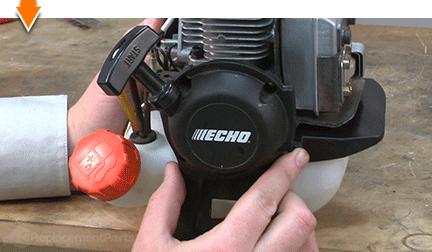
Hold the starter assembly in place while pulling gently on the starter rope. This will engage the starter pawls and ensure proper alignment.
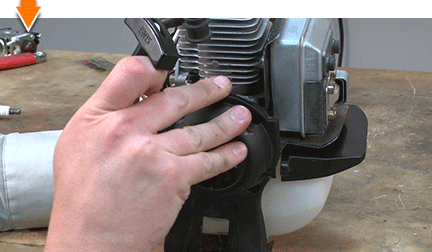
Secure the starter assembly to the engine with the (6) screws.
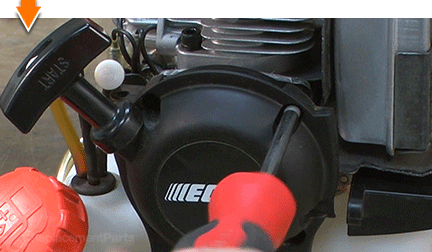
35. Reinstall the intake insulator gasket.
Install the intake insulator gasket in its approximate position against the engine block. (The gasket is secured in later steps; but it must be positioned before the engine cover is reinstalled.)
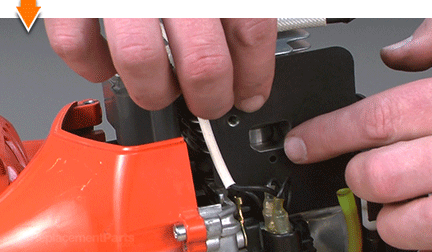
36. Reinstall the engine cover.
Install the engine cover, ensuring that the spark plug wire passes through the hole in the top.
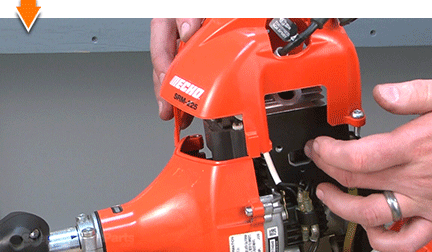
Tuck the ignition wires into the channel behind the engine cover.
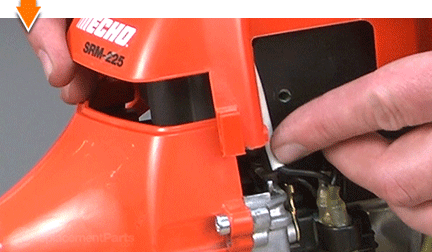
Secure the engine cover with the (2) screws.
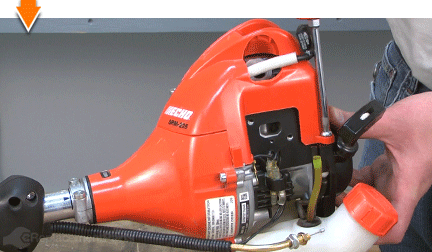
37. Reinstall the spark plug.
Thread the spark plug into the cylinder head.
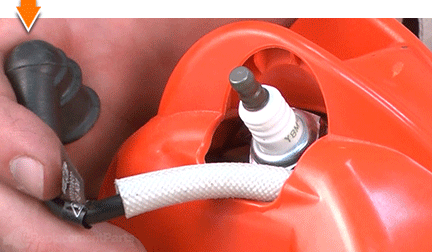
Secure the spark plug with a spark plug wrench.
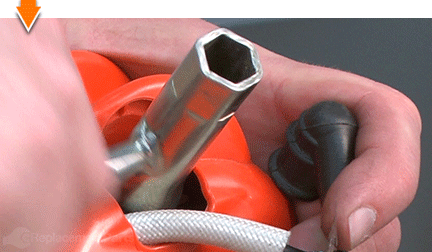
Reinstall the spark plug boot.
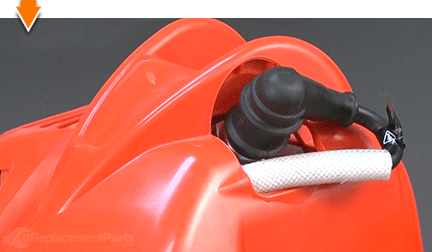
38. Reinstall the intake insulator block.
Install the two nuts into the recesses on the back of the insulator block.
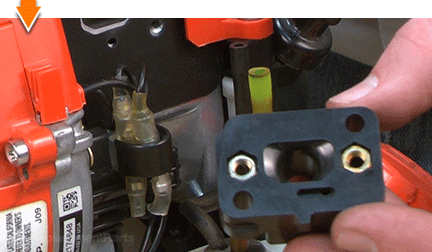
Note that there is a small opening (beneath the main intake port) on the bottom of the insulator block. This opening should align with the small opening beneath the intake port on the engine.
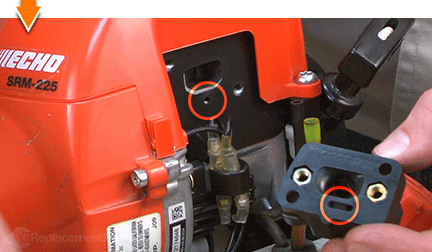
Thread the mounting screws through the holes in the intake insulator block. This will help align the assembly during installation.
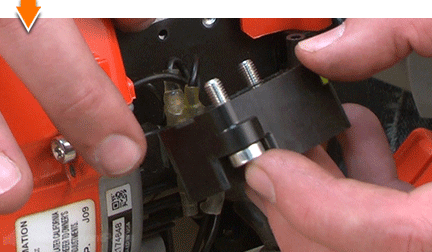
Install the intake insulator block onto the engine.
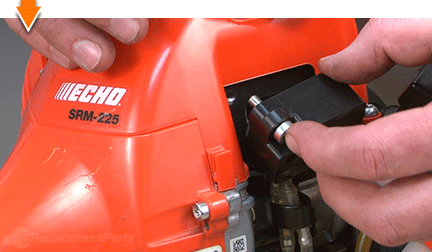
Secure the intake insulator with the (2) screws.
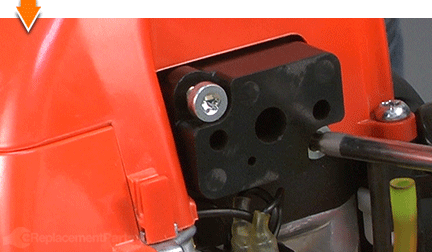
39. Connect the fuel lines to the carburetor.
Remove the gas cap and locate the fuel filter. The filter will be attached to the INCOMING fuel line. Make note of this fuel line for use in the next step.
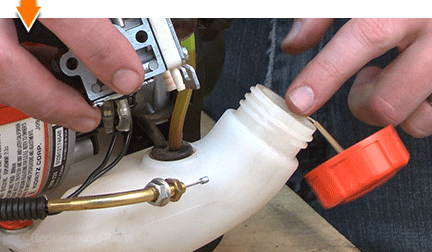
Plug either one of the carburetor ports with the tip of your finger; depress the primer bulb several times. If the primer bulb softens (deflates) without returning to its original shape; you have plugged (and identified) the incoming port.
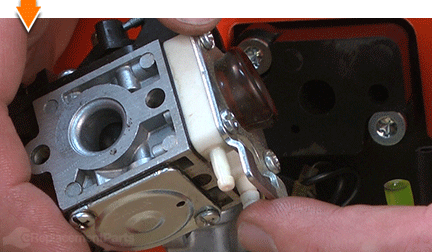
If the primer bulb fills with air (hardens) and wont allow further priming; you have plugged (and identified) the RETURN port.
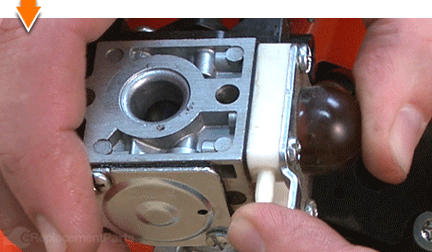
Connect the INCOMING fuel line to the INTAKE port on the carburetor.
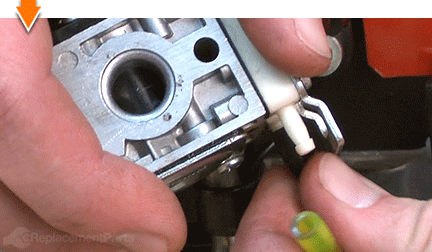
Connect the RETURN fuel line to the RETURN port on the carburetor.
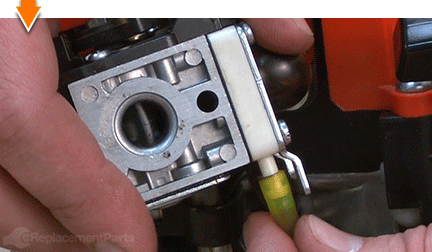
40. Reinstall the throttle cable to the carburetor.
Rotate the throttle lever on the carburetor to fully open the throttle.
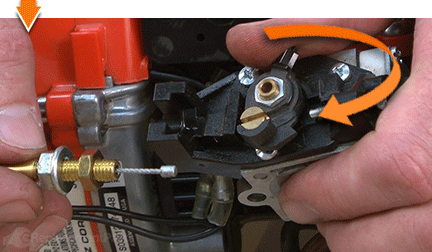
Thread the throttle cable through the brass connector on the top of the carburetor.
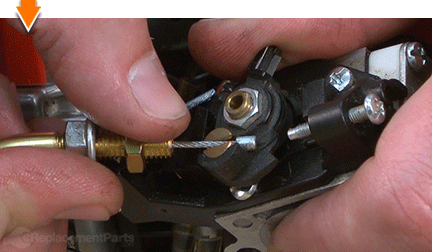
Pull back slightly on the throttle cable (away from the carburetor) to secure the tip of the cable beneath the slots of brass connector.
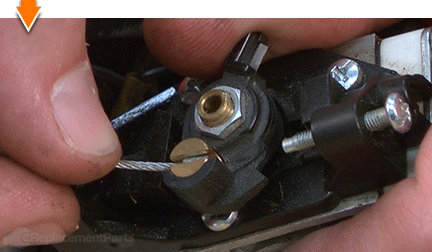
Press the throttle adjustment nut (on the cable) into the recess on the throttle body.
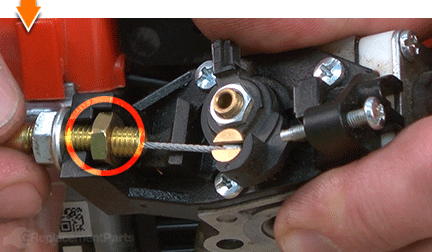
Use a wrench to secure the secondary throttle nut.
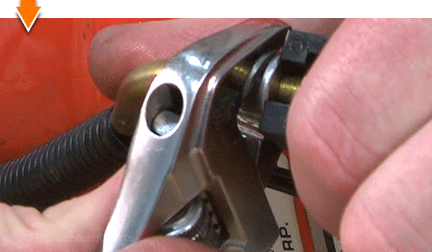
41. Reinstall the carburetor.
Thread the (2) mounting screws through the mounting holes on the air cleaner bracket and the air cleaner case. The bracket should be flush against the interior of the air cleaner case (on the same side as the choke valve).
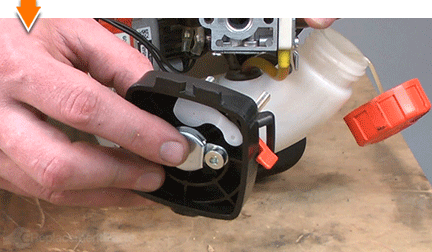
Thread the screws (protruding from the air cleaner case) through the holes on the carburetor assembly.
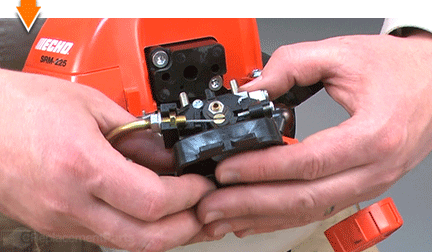
Note that there are two small holes on the intake gasket (besides the main intake opening and the two mounting holes). These small holes need to align with the small hole on the insulator block.
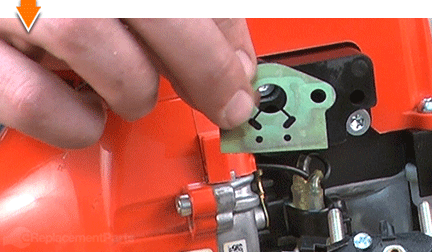
Thread the screws through the mounting holes on the intake gasket and slide the gasket flush against the carburetor.
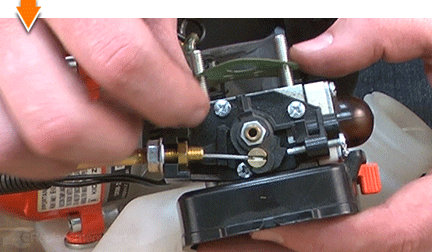
Install the intake assembly (bracket, air cleaner case, carburetor and intake gasket) onto the intake insulator block.
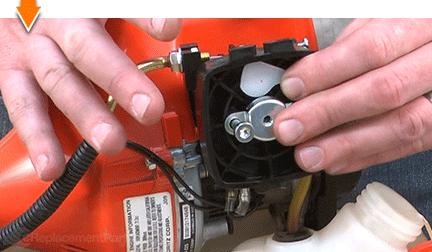
Secure the intake components (bracket, air cleaner case, carburetor and intake gasket) with the screws.
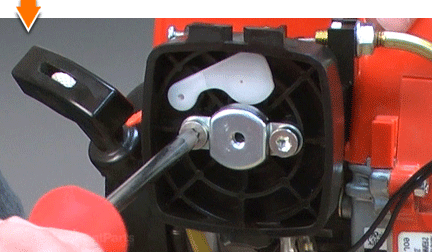
42. Reinstall the air filter.
Install the air filter into the air cleaner case.
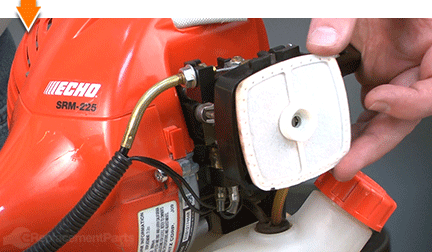
43. Reinstall the air filter lid.
Install the air filter lid onto the air cleaner case.
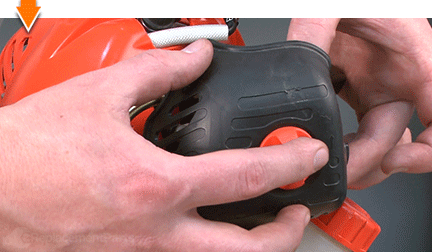
Secure the air filter lid with the thumbscrew.


You don't have to leverage your savings to level your lawns. As you just learned, repairing your own equipment is easy when you follow our step-by-step guides. Not only did you restore trimmer functionality at a fraction of the cost of replacement; you have taken the edge off of future repairs, wherever you may find them.



















































